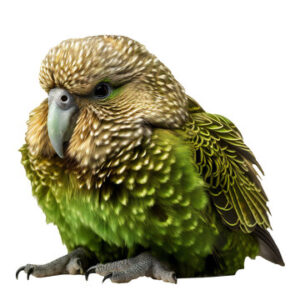Kakapo Definition
It is a unique and fascinating bird known for its nocturnal habits, distinctive appearance, and remarkable behaviors. The Kakapo has a reputation as one of the rarest and most unusual parrot species in the world.
Kakapo General Characteristics & Facts
General Characteristics of Kakapo:
Endangered Status
The Kakapo is one of the world’s rarest and heaviest parrot species. It is critically endangered, and conservation efforts are in place to protect and preserve the remaining population.
Flightless
Kakapos are large and heavy parrots that have lost the ability to fly over time. Instead of flying, they are excellent climbers and use their strong legs and wings to move through trees and on the ground.
Nocturnal
Kakapos are nocturnal birds, meaning they are active primarily during the night. They have adapted to this lifestyle to avoid predators and find food in their native forest habitat.
Herbivores
Kakapos are herbivorous, and their diet primarily consists of native plants, fruits, seeds, and leaves. They are known to feed on various plant species and have a unique sense of smell to locate food.
Unique Breeding Behavior
The Kakapo’s breeding behavior is unusual and influenced by their native environment. They have a lek mating system, where males gather in a designated area to attract females with calls and displays.
Long Lifespan
Kakapos have a relatively long lifespan, with some individuals living up to 90 years in captivity.
Adaptations for Survival
Kakapos have developed several adaptations that help them survive in their natural habitat. Their soft feathers provide them with camouflage, and they have a keen sense of hearing.
Conservation Efforts
Due to the critical status of the Kakapo population, extensive conservation efforts are underway to protect the species. These efforts include predator control, habitat restoration, and a managed breeding program.
Read our Animals Encyclopedia with Complete Facts
Physical Characteristics of Kakapo
- Size and Weight: The Kakapo is one of the heaviest parrots in the world. Adult males can weigh between 2 to 4 kilograms (4.4 to 8.8 pounds), while females are generally slightly lighter. It is a relatively large parrot, with a length of around 58 to 64 centimeters (23 to 25 inches) from beak to tail.
- Body Shape: Kakapos have a stout and chunky body with a broad chest. Their body shape is adapted for a terrestrial lifestyle, as they are flightless birds and spend most of their time on the ground.
- Plumage: Kakapos have soft and fluffy feathers, which set them apart from most other parrot species that have stiff and colorful feathers. The plumage is predominantly mossy green, providing excellent camouflage in their forest habitat. The feathers have yellow or olive-green mottling, giving them a unique appearance.
- Facial Disc: Similar to owls, Kakapos have facial discs formed by specialized feathers around their large eyes. This facial disc enhances their excellent night vision and helps them locate food in the dark.
Continue To Explore All Animals That Start With K
Scientific Classification of Kakapo
The scientific classification of the Kakapo is as follows:
Kingdom: Animalia
Phylum: Chordata
Class: Aves
Order: Psittaciformes
Family: Strigopidae
Genus: Strigops
Species: Strigops habroptilus
View All A-Z Animals List
Key Location of Kakapo
- New Zealand (native and endemic to)
- Codfish Island (where some Kakapo population is found)
- Little Barrier Island (where some Kakapo population is found
Kakapo FAQs
What does Kakapo eat?
The Kakapo primarily eats a variety of plants, seeds, fruits, and leaves. Its diet includes:
- Fruits: Such as rimu, miro, beech, and other native New Zealand trees.
- Seeds: From a variety of plants and trees.
- Leaves: From various plants and trees.
- Flowers: Nectar from certain flowering plants.
- Roots and Rhizomes: From specific plants.

